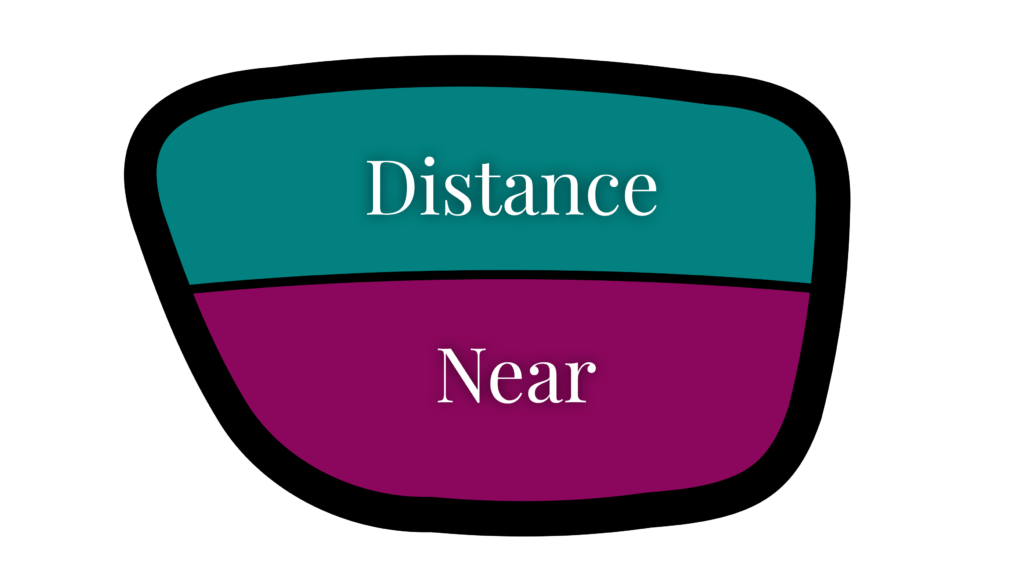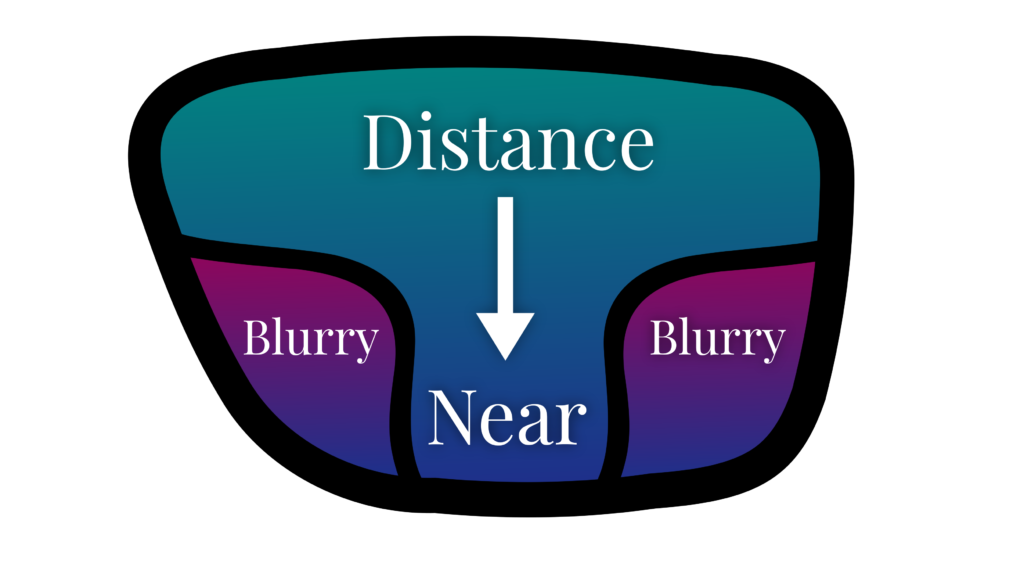No matter what you are using eyeglasses for, there is a lens type best suited for you. Since there are so many types, the following list explains the lenses by focal type, along with additional information regarding special treatments and improvements in lens technology.
Single vision lenses have one single prescription across their entire surface and are suitable in all scenarios, whether you need your glasses for driving, working or reading. One prescription power used to see a single focal length (near, far or intermediate). This type of lens is available for virtually all lens options and/or treatments. The lens materials available are plastic, polycarbonate, or high index up to 1.74.

Bifocals (lined) are eyeglasses with two distinct optical powers. One power on top for distance with a visible line (d-shaped) segment in the bottom for reading. The reading segment is available in different widths (28mm, 35mm, 45mm). There is not an intermediate power in this type of lens. All lens treatments are available on this lens type. The lens material available is plastic and polycarbonate.

Trifocal (lined) lenses are used to correct three visual problems in one pair of glasses. Trifocals will allow you to see distance, intermediate and near. The top part of a trifocal will correct distance vision, the middle part of the lens will correct intermediate vision, and the bottom portion of the lens will correct near vision, which allows you to see distance, intermediate, and near in one pair of glasses. Most trifocals are recognized by the two lines on the bottom of the lens. A trifocal lens is normally prescribed to people over 40; however, the trifocal lens is a fading technology as it is being replaced by the progressive lens. All lens treatments are available on this lens type. The lens material available is plastic and polycarbonate.

Progressive (most advanced in bifocal design) spectacle lenses are corrective lenses used in eyeglasses to correct presbyopia and other disorders. They are characterized by a gradient of increasing lens power, added to the wearer’s correction for the other refractive errors. The gradient starts at the wearer’s distance prescription, at the top of the lens, and reaches a maximum addition power, or the full reading addition, at the bottom of the lens. The length of the progressive power gradient on the lens surface depends on the design of the lens, with a final addition of power between 0.75 and 3.50 diopters. The addition value prescribed depends on the level of presbyopia of the patient. In general, the older the patient, the higher the addition. This lens has the same appearance as a single vision lens. There are not any visible lines. It is referred to as a multifocal lens offering distance, intermediate, and near focal powers. All lens treatments are available on this lens. This lens is available in plastic, polycarbonate, and high index up to 1.74 index.

CR-39 lenses, also known as plastic lenses, are one of the most common lens materials. Plastic lenses are relatively safe, have a low cost, are easy to produce, and provide excellent optics and vision correction. Plastic lenses are half the weight of traditional glass lenses, which makes them more comfortable.
Plastic eyeglass lenses became popular during the 1970s due to the fashion trend for large-sized frames. Plastic lenses (also known as hard resin or CR-39) are half the weight of traditional glass lenses, which makes them more comfortable. Plastic also provides excellent optics and vision correction.
To overcome the softer lens surface, scratch resistant coatings are included on all our plastic lenses. There is a large selection of lens styles that are plastic, which increases its versatility and usage. Plastic; although lacking the built-in UVA/UVB blocking properties of other materials, can be treated with UV protective coatings. Plastic also accepts tints easier than any other material. This material is not suited for sports, children, or safety. (This lens is also recommended with anti-glare.) Plastic or CR-39 lenses have a refractive index of 1.498.
See the above description adding an UV400 coating. This is a coating that filters out 100% of the damaging ultraviolet (UVA/UVB) rays of the sun, which are known to cause damage to the macula and the intraocular lens of the eye. The UV400 coating is colorless. Consider it a permanent sun block lotion for your lenses.
Trivex eyeglass lenses have a refractive index of 1.53 and are ultra-lightweight and much more impact-resistant than regular plastic or glass lenses. It is composed of a urethane-based monomer and manufactured within a cast molding process (as regular plastic lenses) and ideal for drill mount frames (rimless frames). It offers similar UV blocking properties and shatter resistance as polycarbonate lenses. Trivex lenses can be easily tinted. Polycarbonate is thinner, but Trivex lenses are lighter than polycarbonate lenses. Trivex lenses have less internal stress and a higher Abbe value (V-number or constringency) and may result in sharper central and peripheral vision with less chromatic aberration than polycarbonate lenses.
Polycarbonate eyeglass lenses have a refractive index of 1.58 and are the most durable of all lenses and the safest, lightest, and thinnest available. They are made of a virtually unbreakable polycarbonate material that automatically filters harmful UV rays. This allows the material to be ground very thin in the center for minus or nearsighted prescriptions, which allows for much thinner lens edges. These lenses have the highest impact resistance therefore, making them great for kids, playing sports and safety glasses. Polycarbonate is an excellent choice for rimless eyeglasses.
A lens material made of a special plastic and is graded by a number such as 1.60 up to 1.74. Thinner and lighter high-index lens materials have made the world of eyeglasses much different. Thin eyeglasses are attractive; thick ones aren’t. Light eyeglasses are comfortable; heavy ones aren’t. This impact resistant design has become a popular choice of patients who want the lightest, thinnest UV protected lenses possible. This is a great option for a patient with high prescriptions giving them a more attractive lens. (This lens is also recommended with anti-glare.)
The High Index 1.67 Lenses are made from special plastic material that refracts light in a different way than regular plastic. This material is also thinner and lighter weight than regular plastic lenses and although it is a strong material, it is not unbreakable and not as shatter resistant as polycarbonate. This material is great for higher prescriptions and is often recommended by doctors for its optical quality and also suitable for rimless eyeglasses. The bottom line is that thin eyeglass lenses are more comfortable and attractive than thick ones.
High Index 1.74 Lenses are approximately 15% thinner than High Index 1.67 which makes it approximately 50% thinner than conventional plastic in most RX (prescription) ranges. High Index 1.74 lenses are also scratch resistant and UV400 coated, and most suitable for higher prescriptions. (NOTE: You must order Crizal Advance or Crizal Sapphire when ordering this lens. 1.74 Lenses are not made without anti -glare).
UV Protection shields your eyes from sun rays that can damage your eyes. Solid lens tinting adds tint to your lens and is available in various colors. Although tints could be purely cosmetic, we provide it as a sunglass tint. The percentage of color refers to the amount of color in the lens and the higher the percentage, the darker the lens. The lens tint that we recommend and provide is 80%. This is a sunglass tint. Please provide additional instructions if you need a lighter tint.
Transitions (photochromatic) lenses use an adaptive lens technology that is sensitive to ultraviolet light, causing the lenses to lighten to completely clear indoors, and within minutes darken to a sun tint outdoors in direct sunlight. Right in any light. The #1 photo chromic lenses recommended by eye doctors. Transition Lenses block out 100% UV radiation and reduce glare. Transition lenses are dependent on the ultraviolet rays of the sun to activate them. For this reason, they do not darken inside of the car, and they will darken on overcast or cloudy days. The brighter the sun, the darker they get, getting as dark as sunglasses in bright light.
Your eyes, like your skin, need protection from everyday sun exposure. Recent research suggests cumulative damage from UVA and UVB rays may contribute to serious age-related diseases. Transition Lenses block out 100% UV radiation and reduce glare. They’re as clear as regular eyeglasses indoors until dangerous rays are present. Then the brighter the sun, the darker they get, getting as dark as sunglasses in bright light. Transitions automatically protect from glare and UV- on sunny days, cloudy days, and everything in between. Because the windshield of your car filters ultraviolet light, your transition lenses will not darken adequately in the car for the brightness of the sun. Transitions are increasingly becoming more and more popular due to the fact they get darker quicker outdoors and lighter quicker indoors.
Some wearers of transitions also have a separate pair of prescription sunglasses or a clip-on for inside the car. Transition lenses do darken on overcast or cloudy days because the ultraviolet lights still penetrate through the clouds on the cloudiest of winter days.
At Carytown Optical, your satisfaction of your transition lenses is fully guaranteed. If you are not completely satisfied with your choice in Transition Generation 8 Gray, Brown, Graphite-Green, Amber, Sapphire, Amethyst, or Emerald lenses, they will be remade for you within 60 days of your purchase; in clear or in a lightly tinted lens at no additional charge.
You’ll be amazed at how much better your vision can be through polarized lenses, which is better than natural human vision. In layman’s terms, a polarized lens is like having a Venetian blind built into your lens. It organizes the light, which is bombarding your sight from all angles. The polarization only allows light in at one angle or plane, which eliminates glare. They are great for anyone who spends their time outdoors: tennis, jogging, biking, boating, or fishing. Once you try them, you’ll never go back!
Many colors are available, but the most common colors used are gray and brown. This is better for sunglasses than your standard tinting since vertically polarized lenses decrease more glare by blocking horizontal polarized reflected light. Polarization also blocks 100% of harmful UV rays. Polarized lenses can reduce or completely eliminate glare. Glare can be caused by direct light from a single source, such as sunlight or from light reflected. Polarized lenses are ideal for surroundings such as water, snow, cement, ice, and sand.
They are great for: Anyone who spends their time outdoors; Golf, tennis, skiing, jogging, biking, boating, or fishing; Improving depth perception and overall visual comfort; Cutting glare off the surface of water. Polarized lenses are also great for driving. Glare is caused by light reflected off the road surface, buildings, dust, and car windshields. That reflected image of the dashboard off the windshield can be distracting and even dangerous when you’re driving!! Polarized lenses will reduce the reflections and provide you with clear and comfortable vision.
There are some who do not or should not wear polarized lenses, such as pilots and anyone else dependent on reading digital gauges. The polarization makes it impossible to read gauges that are LCD.
Anti-reflective treatment is applied to the front and back surface. This treatment is the perfect companion for high-index lenses. All lens materials block some light from passing through that is reflected from the lens surface, causing distractions, and reducing vision clarity. AR-coated on high-index lenses eliminate lens reflections and transmit up to 99.5 percent of light to the eye for optimum vision. Anti-reflective coating has a real advantage for night drivers since it provides sharper night vision with less glare. Anti-glare is also great, cosmetically giving the lenses an invisible appearance. In general, your experience will be that your eyes are less tired, especially with extended computer use, your eyes will not be hidden by glare and your lenses will have a much tougher scratch resistant surface. We recommend AR Coating with every prescription. UV Protection Coating for Plastic Lenses (Not needed if you select Blue Light Protection)
UV Protection is a treatment applied to a lens to protect the eyes from the exposure to harmful UV rays. This is a coating that filters out 100% of the damaging ultraviolet (UVA/UVB) rays of the sun, which are known to cause damage to the macula and the intraocular lens of the eye. The UV400 coating is colorless. Consider it a permanent sun block lotion for your lenses. This extra treatment is not necessary on all lens materials since certain lens materials already block harmful UV rays as discussed below.
Crizal Avance with Scotch Guard gives you everything you’ve ever wanted from your lenses:
- Provides the best possible cosmetic appearance for your lenses by preventing reflections and allowing others to see your eyes completely clear.
- Creates clear vision by helping the maximum amount of light to enter your eyes as well as eliminating back side lens reflections such as seeing the reflection of your own eye or eyelashes.
- Prevents the reflections that cause eyestrain and fatigue.
- Incredibly easy to clean, with greater smudge and dirt resistance. It is fused into the lens material, making it extremely durable.
- Provides unbeatable two-sided scratch resistance.
Crizal Sapphire is the best Anti-Reflective Coating available today and is fused into the lens material for a diamond-hard protection which won’t peel or lift off the lens like many lower quality reflection free coatings. This scratch resistant coating provides the sharpest vision of any no-glare lens available on the market. Crizal Sapphire virtually eliminates reflections from headlights, taillights and other light sources which allow drivers to make faster adjustments to changing conditions. Crizal Sapphire has a distinct blue appearance to the lens. The Crizal Avance is less noticeable on the lens surface.
NOTE: You must order Crizal Advance or Crizal Sapphire when ordering High Index 1.74 lenses.
Blue Light Protection reduces harmful blue-violet light exposure from computers and other digital devices. Blue light is now believed to play a significant role in the onset of age-related macular degeneration. The Blue Clear Lens can prevent this as well as headaches, fatigue and blurred vision associated with digital eye strain. Blue Clear provides:
- Blue-Violet light protection.
- Clear and comfortable vision.
- Reduces glare.
- Resists scratches and smudges.
- Repels dust and water.
- Blue Clear Blocks Blue Violet light which interrupts the production of melatonin, thus allowing for a more restful sleep and help to eliminate insomnia.
- Blue Clear lenses are not available in transition
Crizal SunShield offers improved UV protection by incorporating a new optimized formulation to eliminate backside reflections (allowing 30 percent less UV light into the eye than ordinary sun lenses). It helps protect the wearer from UV- related diseases, such as macular degeneration, cataracts, and pterygium. In addition, Crizal SunShield lenses eliminate 99 percent of visible glare and light reflections on the back side of the lens, which makes vision more comfortable, especially in sunny conditions. Crizal SunShield lenses incorporate the advanced technologies of Crizal Avance™ lenses with Scotchgard™ Protector, the SR BoosterTM Layer, and anti-static properties to the back side of the lens to enhance scratch protection and resistance to dust and water.
Polished lens edges simply look better because they are clear and therefore less noticeable. Lens edge polishing is a cosmetic treatment that transforms the lens edge from a cloudy, frosted look to a crystal-clear shine making lenses appear thinner. An edge polish is most effective with high prescriptions and is available for all lens materials and designs. Polished lens edges give your eyewear a more finished look; but they are recommended most in rimless, semi rimless and metal frames. In plastic frames, polished edges can tend to reflect light and a satin edge polish is recommended. Please notify us with your order if you prefer that.


